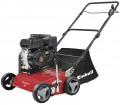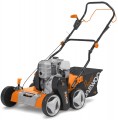Type
The type determines the method of operation and, accordingly, the general purpose and specific application of the aerator.
—
Verticutter(knife). The name comes from the English "vertical cutter" — "vertical blade". In accordance with this, the working tool of the verticutter is a horizontal shaft with vertical blades mounted on it. In the process of work, such an aggregate leaves characteristic slots in the ground, which contribute to the penetration of air, moisture and nutrients into the soil. In this case, the blades cut the roots of the grass, thus stimulating their growth in loosened soil and, accordingly, the growth of the grass itself. In addition, verticutters are good (better than the
scarifiers described below) for removing debris from the surface of the earth. They easily cope with both “lying” debris like wood chips or acorns, as well as with dry grass, moss cover, etc. Therefore, the main purpose of such units is the cleaning of neglected lawns that have not been cultivated for a long time, which require intensive processing. It should be noted that verticutters also include hand-held devices (see "Engine type") with a working tool in the form of characteristic "sprocket" wheels: according to the specifics of work, they are a cross between rake and knife models, however, the teeth of the "sprockets" are more similar on knives than on the antennae of scarifiers, and they penetrate deeper
....
— Scarifier (rake). Aerators of this type work on the principle of a wire rake: like verticutters, they use a working tool in the form of a shaft, but not blades are installed on the shaft, but wire “antennae”. Thus, most scarifiers do not so much work on the soil as they comb the lawn, removing debris from it — like last year's leaves or dry grass. However, there are models that are able to pierce the soil; however, even with them, the depth of influence is very small — up to 5 mm. In general, such units are designed mainly to maintain healthy already “cultivated” lawns that do not require intensive processing.
— Combined. Models that can be used both as a knife aerator and as a rake aerator. Features of both types are described in detail above. And to realize their functions in one aerator, it is possible through the use of interchangeable shafts: by installing the appropriate shaft, the owner can turn the unit either into a verticutter or a scarifier. Note that only those units that are initially equipped with working tools of different types belong to the combined ones. If the possibility of replacement is provided, but there is only one shaft in the kit, the aerator will be assigned to one of the types described above.Number of depth settings
The number of nozzle depth adjustments provided in the design of the aerator. Note that we can talk not only about the depth, but also, in the case of scarifiers, about the height of processing (for more details, see above). Anyway, the
more depth (height) settings, the wider the choice of the operator, the more accurately he can choose the optimal value for a particular situation.
Working mechanism
The design of the working mechanism provided in the aerator, in other words, the number and types of working elements installed on the shaft. For verticutters (see "Type") such elements are blades, for scarifiers — spring teeth. For
combined models, in this case, the design of both working shafts is indicated, for example "14 knives / 20 spring teeth".
Bag volume
The total volume of the garbage collection bag provided with the aerator.
The larger the bag, the more garbage it can hold, the less often it will have to be emptied. On the other hand, the weight and dimensions of a capacious container will also be considerable (this is especially true for rigid varieties, in which the size does not depend on fullness — see "Bag Type"). Yes, and carrying too much garbage “with you” is not always convenient, especially with the small size and weight of the unit itself. Therefore, manufacturers, usually, choose this parameter taking into account the specifics of the use of the aerator. So, in low-power models designed for small areas, the volume of the bag is also small, and in high-performance professional devices it can exceed 50 liters.
Engine size
The volume of the petrol engine installed in the corresponding type of aerator (see "Engine type"). Usually, the larger the engine (with the same type of internal combustion engine, see above) — the higher its power and the more fuel it consumes. In general, this parameter is for reference: manufacturers select it in such a way as to provide the necessary practical characteristics (in particular, the same power).
Motor power
Aerator engine power expressed in horsepower (hp). In the case of aerators, this unit is used only for models with gasoline engines (see "Engine type"). Note that some time ago, the designation of power in horsepower was standard for internal combustion engines, but now watts are increasingly used for this; so hp is used more as a tribute to tradition than as an urgent need, and most often these data are duplicated in watts. However, even if there is no such duplication, some units can be easily converted to others: 1 hp. approximately corresponds to 735 watts. For more information about the value of engine power, see the paragraph of the same name below.
Motor power
The power of the aerator motor, expressed in watts. Today, the watt is the common unit of power and is used for both electric and petrol models (see "Engine type"). In general, the
more powerful the motor, the higher the performance of the unit, the greater the depth of processing and the working width (see above) can be provided in the aerator; however, the consumption of electricity / fuel also directly depends on the power. Therefore, when choosing an engine for their equipment, manufacturers proceed from a reasonable compromise between these properties, and in general, engine power allows you to evaluate the performance of the unit and its suitability for large volumes of work.
Fuel tank volume
The volume of the fuel tank installed in the aerator with a petrol engine (see "Engine type"). Ceteris paribus, the more capacious the tank, the longer the unit is able to work on a single refill, the less often it will have to be refilled. On the other hand, aerators usually work in close proximity to a place where a supply of fuel can be stored, and refilling is not much of a problem; and a tank that is too large would be bulky and heavy. Therefore, the volume of fuel tanks, usually, is small — within a few liters (usually from 1.5 to 4 liters).
Also note that having data on fuel consumption, it is possible to calculate the specific time spent on one gas station — although it is quite approximate; see "Fuel Consumption" for details.
Front wheel diameter
One of the parameters on which the diameter of the wheels depends is the weight of the unit: a heavy powerful aerator requires large wheels, and a light model can get by with small ones. In addition, the larger the wheels, the easier they cope with various obstacles, the better the car is suitable for difficult terrain, where you have to move through bumps, stones, etc. However, the downside of such cross-country ability is an increase in the cost of the aerator.

